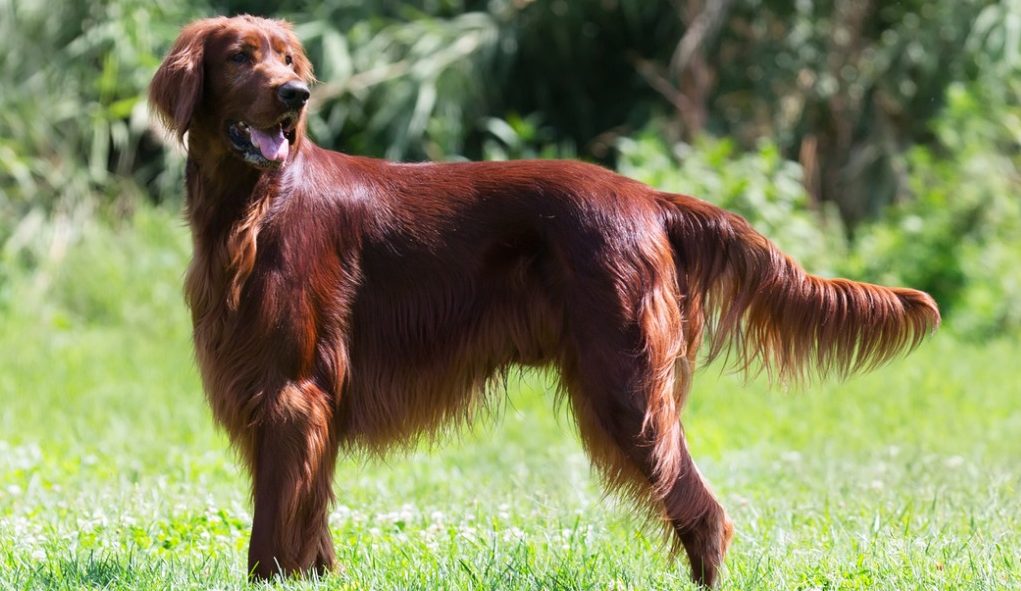-
Activity Level:
high
-
Shedding Level:
moderate
-
Grooming Level:
moderate
-
Trainability:
high
-
Good for Novice Owners:
moderate
-
Adaptability:
moderate
-
Kid/Pet Friendly:
often
-
Prey Drive:
high
-
Watchdog:
very alert
- Average Size: Medium
- Average Lifespan: 12-15 years
- Registered?: aca, akc
Irish Setter Dog Breed Information
Overview
Temperament
Adaptability
Health
Owner Experience
Grooming
Activity Level
Size
Life Span
Did You Know?
The Irish Setter, also referred to as a Red Setter or Irish Red Setter, is a popular breed of gundog. They are also popular family dogs and therapy dogs, and are even popular show dog breeds.
They were originally bred in Ireland in the 1800s for hunting, specifically to set, locate, and point game birds. It is believed that they were developed from a mix of English Setter, Spaniel, and Pointer breeds in addition to the Gordon Setter.
This required plenty of energy, endurance, focus, a fantastic sense of smell, and the ability to navigate fields, dry terrain, and wet terrain; at which the Irish Setter excels across the board. This dog breed came to the United States early in the 19th century. The AKC fully recognized the Irish Setter in 1878 as part of the Sporting Group.
Irish Setters are known for their affectionate and loving natures and energetic, playful personalities. This dog breed is intelligent, outgoing, and active. Well-socialized, they are good with children, other dogs, and other larger household pets.
They are even considered one of the kid-friendly dog breeds. As a hunting breed, the Irish Setter does have a prey drive, so they are prone to chase small animals and may not get along with cats in the house. They usually do better with smaller animals that they have been raised and socialized with.
This dog breed is very energetic, so any interactions between young kids and puppies should be supervised to ensure things don’t get too rambunctious. The Irish Setter makes a great family dog and is a sweet-natured companion. They make a decent watchdog as they are alert and will let you know when someone or something is around. They also tend to enthusiastically greet visitors.
The Irish Setter is a moderately adaptable dog breed. They are best suited for homes with fenced-in yards and plenty of room to run. Because they are one of the most active dog breeds and require so much daily activity, they do not tend to do well in apartments.
They also thrive on human attention and companionship, so they do not do well with long periods of alone time. Irish Setters tend to do well in just about any climate. As with most dog breeds, they are sensitive to extreme heat or cold.
Potential health conditions to be aware of in Irish Setters can include hip dysplasia, osteosarcoma, celiac disease, hypothyroidism, Von Willebrand’s disease, and progressive retinal atrophy. Good breeding practices and the health of the parents make a big difference in the health of Irish Setter puppies.
Reputable breeders will screen their dogs to make sure they are not passing preventable issues to puppies. Make sure you talk to the breeder about the health and genetic history of the parents.
You can also ask about any health tests or clearances that have been done. The Irish Setter Club of America, Inc. recommends a DNA test for PRA-rcd1 to monitor for Progressive Retinal Atrophy, a hip evaluation, and a thyroid evaluation.
As a deep-chested dog breed, Irish Setters are also at a higher risk for bloat. Because bloat in dogs can be dangerous and quickly becomes fatal if the stomach flips (i.e.; if gastric torsion occurs), it’s important to know how to reduce the risk and to know what signs mean it’s time to get to the emergency vet.
Irish Setters are intelligent, eager to please their owners, and tend to pick up things quickly, but they are energetic and can become bored easily. They tend to be better suited to dog owners who have experience with training and caring for high-energy dog breeds.
An Irish Setter can be a good fit for a novice or first-time dog owner, but puppy training and obedience classes are highly recommended. In general, it’s important to start training as early as possible with this dog breed and implement consistent training in general obedience. They respond best to patient, consistent, fun, and positive training.
Although it’s important to be consistent in training, it’s also important to keep training sessions fun and interesting. Because these dogs pick up on things quickly, they are easily bored with too much repetition. If you find your Irish Setter getting bored or distracted during training, try to exercise them beforehand, keep sessions on the shorter side, or switch up rewards. These are all tips to keep your dog engaged during training sessions and can help keep a dog focused.
Irish Setters have a soft, flat coat that tends to be medium-length. They have a double coat where the top coat is fine and the undercoat will bulk up in the winter. Common coat colors include Mahogany, Chestnut, and Red. Because the Irish Setter has a longer coat, it needs frequent brushing to remove tangles and prevent mats from forming.
Brushing your Irish Setter’s coat a few times a week or daily and the occasional bath should be sufficient to keep it properly maintained. This dog breed will shed moderately year-round and more heavily twice a year during seasonal shedding sessions. During these times, it may make sense to brush your dog’s coat every day. A bristle brush, a pin brush, a long-toothed comb, and an undercoat rake can be good types of dog grooming brushes to have on hand for this coat type.
In addition to coat care and maintenance, you will also need to take care of your Irish Setter’s nails, ears, and teeth. Trimming nails once or twice monthly is usually sufficient to keep nails from getting too long and hindering movement, but they may need to be trimmed more often if they are not wearing down as much between trimmings. A good rule of thumb is that if you hear your dog’s nails clicking on the floor or notice them getting snagged on things, it’s time for a trim.
Irish Setters also have long, floppy ears. They’re adorable, but they also tend to trap dirt, debris, and moisture more often, which can lead to ear infections. So, it’s important to regularly check your dog’s ears and carefully clean them as needed to help prevent ear infections. Additionally, proper dental care for dogs is the best defense against tooth decay and gum disease.
Dental disease is one of the most common health problems in dogs and it’s also one of the most preventable. Brushing your dog’s teeth every day, in addition to cleanings at the vet when needed, helps prevent the tartar buildup that causes painful dental disease later in life. You can also supplement your efforts with dental hygiene chews and other vet-approved methods.
It’s important to start getting your Irish Setter used to having their paws, mouth, and ears handled as a puppy. If you get them used to it early on and make sure the experience stays a positive and rewarding one, grooming will be much easier for both of you throughout your dog’s life. Plus, it can become a calming and relaxing experience that also strengthens the bond you have with your dog!
The Irish Setter is a high-energy dog breed that requires plenty of daily exercise and a job to do in order to stay happy and healthy. Long, daily walks, some playtime, and some time to run each day should be sufficient for your Irish Setter, but they will certainly not say no to more activity than that.
They make great running partners, are likely to enjoy going on hikes with you, and may also enjoy swimming. Just make sure puppies are finished growing and their bones are done developing before you take on higher-impact activities. This will help avoid damage to growing bones and joints. Swimming can be a great low-impact activity for dogs.
Irish Setters are one of the dog breeds that tend to love water, so you may have trouble keeping them away from it! But, this could also mean that they will love to go swimming. They love to run off-leash, but it is important that they have mastered basic recall commands before they are permitted to be off-leash. Otherwise, they may “play deaf” and continue running to their heart’s content. They are also a good fit for dog sports like obedience, agility, rally, tracking, hunting, flyball, dock diving, and more.
A fully-grown Irish Setter usually stands 25-27 inches tall at the shoulder and weighs 60-70 pounds. Females tend to average around 25 inches tall and weigh 60 pounds while males tend to average around 27 inches tall and weigh 70 pounds.
Irish Setters generally live for 12-15 years on average.
One of the facts about Irish Setters is that they are mascots. The national bus company in Ireland is called Bus Éireann and its corporate logo is an Irish Setter.









